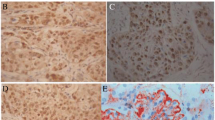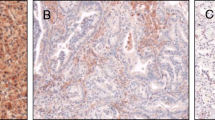Abstract
As a result of alternative splicing and differential promoter usage, RASSF5 exists in at least three isoforms (RASSF5A–RASSF5C), which may play different roles in tumorigenesis. The present study was to detect the role of RASSF5A, B and C in esophageal squamous cell carcinoma (ESCC) and clarify the critical CpG sites of RASSF5A, in order to clarify more information on the role of RASSF5 with regard to the pathogenesis of ESCC. Frequent silencing of RASSF5A but not RASSF5B and RASSF5C were found in esophageal cancer cell lines and the silencing of RASSF5A may be reversed by 5-Aza-dC or TSA treatment. The aberrant CpG island 1 methylation of RASSF5A induces silencing of its expression in TE13 cell line. Decreased mRNA and protein expression of RASSF5A was observed in ESCC tumor tissues and was associated with RASSF5A CpG island 1 methylation status. Unlike RASSF5A, expression variation of RASSF5B and RASSF5C was not found in ESCC tissues. Aberrant promoter methylation of RASSF5C was also not found in ESCC. RASSF5A methylation and protein expression were independently associated with ESCC patients’ survival. These data indicated that the inactivation of RASSF5A through CpG island 1 methylation may play an important role in ESCC carcinogenesis, RASSF5A may be a functional tumor suppressor and may serve as a prognostic biomarker for ESCC.





Similar content being viewed by others
References
Nagaraja V, Eslick GD (2014) Forthcoming prognostic markers for esophageal cancer: a systematic review and meta-analysis. J Gastrointest Oncol 5:67–76
Shahbaz Sarwar CM, Luketich JD, Landreneau RJ, Abbas G (2010) Esophageal cancer: an update. Int J Surg 8:417–422
Sun G, Wang S, Hu X, Su J, Huang T, Yu J, Tang L, Gao W, Wang JS (2007) Fumonisin B1 contamination of home-grown corn in high-risk areas for esophageal and liver cancer in China. Food Addit Contam 24:181–185
Guohong Z, Min S, Duenmei W, Songnian H, Min L, Jinsong L, Hongbin L, Feng Z, Dongping T, Heling Y, Zhicai L, Shiyong L, Quansheng G, Xiaoyun L, Yuxia G (2010) Genetic heterogeneity of oesophageal cancer in high-incidence areas of southern and northern China. PLoS ONE 5:e9668
Cully M, Downward J (2008) SnapShot: Ras Signaling. Cell 133 (1292–1292):e1
Richter AM, Pfeifer GP, Dammann RH (2009) The RASSF proteins in cancer; from epigenetic silencing to functional characterization. Biochim Biophys Acta 1796:114–128
Dammann R, Li C, Yoon JH, Chin PL, Bates S, Pfeifer GP (2000) Epigenetic inactivation of a RAS association domain family protein from the lung tumour suppressor locus 3p21.3. Nat Genet 25:315–319
Donninger H, Vos MD, Clark GJ (2007) The RASSF1A tumor suppressor. J Cell Sci 120:3163–3172
Guo W, Dong Z, Chen Z, Yang Z, Wen D, Kuang G, Guo Y, Shan B (2009) Aberrant CpG Island hypermethylation of RASSF1A in gastric cardia adenocarcinoma. Cancer Invest 27:459–465
Guo W, Cui L, Wang C, Guo Y, Shen S, Kuang G, Dong Z (2014) Decreased expression of RASSF1A and up-regulation of RASSF1C is associated with esophageal squamous cell carcinoma. Clin Exp Metastasis 31:521–533
Vavvas D, Li X, Avruch J, Zhang XF (1998) Identification of Nore1 as a potential Ras effector. J Biol Chem 273:5439–5442
Tommasi S, Dammann R, Jin SG, Zhang XF, Avruch J, Pfeifer GP (2002) RASSF3 and NORE1: identification and cloning of two human homologues of the putative tumor suppressor gene RASSF1. Oncogene 21:2713–2720
Hesson L, Dallol A, Minna JD, Maher ER, Latif F (2003) NORE1A, a homologue of RASSF1A tumour suppressor gene is inactivated in human cancers. Oncogene 22:947–954
Shinmura K, Tao H, Nagura K, Goto M, Matsuura S, Mochizuki T, Suzuki K, Tanahashi M, Niwa H, Ogawa H, Sugimura H (2011) Suppression of hydroxyurea-induced centrosome amplification by NORE1A and down-regulation of NORE1A mRNA expression in non-small cell lung carcinoma. Lung Cancer 71:19–27
Lee CK, Lee JH, Lee MG, Jeong SI, Ha TK, Kang MJ, Ryu BK, Hwangbo Y, Shim JJ, Jang JY, Lee KY, Kim HJ, Chi SG (2010) Epigenetic inactivation of the NORE1 gene correlates with malignant progression of colorectal tumors. BMC Cancer 10:577
Calvisi DF, Donninger H, Vos MD, Birrer MJ, Gordon L, Leaner V, Clark GJ (2009) NORE1A tumor suppressor candidate modulates p21CIP1 via p53. Cancer Res 69:4629–4637
Geli J, Kogner P, Lanner F, Natalishvili N, Juhlin C, Kiss N, Clark GJ, Ekström TJ, Farnebo F, Larsson C (2008) Assessment of NORE1A as a putative tumor suppressor in human neuroblastoma. Int J Cancer 123:389–394
Djos A, Martinsson T, Kogner P, Carén H (2012) The RASSF gene family members RASSF5, RASSF6 and RASSF7 show frequent DNA methylation in neuroblastoma. Mol Cancer 11:40
Nakamura N, Carney JA, Jin L, Kajita S, Pallares J, Zhang H, Qian X, Sebo TJ, Erickson LA, Lloyd RV (2005) RASSF1A and NORE1A methylation and BRAFV600E mutations in thyroid tumors. Lab Invest 85:1065–1075
Irimia M, Fraga MF, Sanchez-Cespedes M, Esteller M (2004) CpG island promoter hypermethylation of the Ras-effector gene NORE1A occurs in the context of a wild-type K-ras in lung cancer. Oncogene 23:8695–8699
Steinmann K, Sandner A, Schagdarsurengin U, Dammann RH (2009) Frequent promoter hypermethylation of tumor-related genes in head and neck squamous cell carcinoma. Oncol Rep 22:1519–1526
Geli J, Kiss N, Lanner F, Foukakis T, Natalishvili N, Larsson O, Kogner P, Höög A, Clark GJ, Ekström TJ, Bäckdahl M, Farnebo F, Larsson C (2007) The Ras effectors NORE1A and RASSF1A are frequently inactivated in pheochromocytoma and abdominal paraganglioma. Endocr Relat Cancer 14:125–134
Lorente A, Mueller W, Urdangarín E, Lázcoz P, Lass U, von Deimling A, Castresana JS (2009) RASSF1A, BLU, NORE1A, PTEN and MGMT expression and promoter methylation in gliomas and glioma cell lines and evidence of deregulated expression of de novo DNMTs. Brain Pathol 19:279–292
Macheiner D, Heller G, Kappel S, Bichler C, Stättner S, Ziegler B, Kandioler D, Wrba F, Schulte-Hermann R, Zöchbauer-Müller S, Grasl-Kraupp B (2006) NORE1B, a candidate tumor suppressor, is epigenetically silenced in human hepatocellular carcinoma. J Hepatol 45:81–89
Macheiner D, Gauglhofer C, Rodgarkia-Dara C, Grusch M, Brachner A, Bichler C, Kandioler D, Sutterlüty H, Mikulits W, Schulte-Hermann R, Grasl-Kraupp B (2009) NORE1B is a putative tumor suppressor in hepatocarcinogenesis and may act via RASSF1A. Cancer Res 69:235–242
Kondo Y, Shen L, Issa JP (2003) Critical role of histone methylation in tumor suppressor gene silencing in colorectal cancer. Mol Cell Biol 23:206–215
Meng CF, Zhu XJ, Peng G, Dai DQ (2007) Re-expression of methylation-induced tumor suppressor gene silencing is associated with the state of histone modification in gastric cancer cell lines. World J Gastroenterol 13:6166–6171
Livak KJ, Schmittgen TD (2001) Analysis of relative gene expression data using real-time quantitative PCR and the 2(-Delta Delta C(T)) method. Methods 25:402–408
Das PM, Ramachandran K, vanWert J, Singal R (2004) Chromatin immunoprecipitation assay. Biotechniques 37:961–969
Yu L, Liu C, Vandeusen J, Becknell B, Dai Z, Wu YZ, Raval A, Liu TH, Ding W, Mao C, Liu S, Smith LT, Lee S, Rassenti L, Marcucci G, Byrd J, Caligiuri MA, Plass C (2005) Global assessment of promoter methylation in a mouse model of cancer identifies ID4 as a putative tumor-suppressor gene in human leukemia. Nat Genet 37:265–274
Sasaki M, Anast J, Bassett W, Kawakami T, Sakuragi N, Dahiya R (2003) Bisulfite conversion-specific and methylation-specific PCR: a sensitive technique for accurate evaluation of CpG methylation. Biochem Biophys Res Commun 309:305–309
Umemoto M, Yokoyama Y, Sato S, Tsuchida S, Al-Mulla F, Saito Y (2001) Carbonyl reductase as a significant predictor of survival and lymph node metastasis in epithelial ovarian cancer. Br J Cancer 85:1032–1036
Li LC, Dahiya R (2002) MethPrimer: designing primers for methylation PCRs. Bioinformatics 18:1427–1431
Jenuwein T, Allis CD (2001) Translating the histone code. Science 293:1074–1080
Di Gioia S, Bianchi P, Destro A, Grizzi F, Malesci A, Laghi L, Levrero M, Morabito A, Roncalli M (2006) Quantitative evaluation of RASSF1A methylation in the non-lesional, regenerative and neoplastic liver. BMC Cancer 6:89
Hesson L, Bièche I, Krex D, Criniere E, Hoang-Xuan K, Maher ER, Latif F (2004) Frequent epigenetic inactivation of RASSF1A and BLU genes located within the critical 3p21.3 region in gliomas. Oncogene 23:2408–2419
Chow LS, Lo KW, Kwong J, Wong AY, Huang DP (2004) Aberrant methylation of RASSF4/AD037 in nasopharyngeal carcinoma. Oncol Rep 12:781–787
Lázcoz P, Muñoz J, Nistal M, Pestaña A, Encío I, Castresana JS (2006) Frequent promoter hypermethylation of RASSF1A and CASP8 in neuroblastoma. BMC Cancer 6:254
Chen SH, Chan SC, Chao YK, Yen TC (2013) Detection of synchronous cancers by fluorodeoxyglucose positron emission tomography/computed tomography during primary staging workup for esophageal squamous cell carcinoma in Taiwan. PLoS ONE 8:e82812
Brock MV, Hooker CM, Ota-Machida E, Han Y, Guo M, Ames S, Glöckner S, Piantadosi S, Gabrielson E, Pridham G, Pelosky K, Belinsky SA, Yang SC, Baylin SB, Herman JG (2008) DNA methylation markers and early recurrence in stage I lung cancer. N Engl J Med 358:1118–1128
Acknowledgments
This research was supported by Grants from the National Natural Science Foundation (No. 81101854). We thank the patients and control individuals for taking part in this study.
Author information
Authors and Affiliations
Corresponding author
Electronic supplementary material
Below is the link to the electronic supplementary material.
Rights and permissions
About this article
Cite this article
Guo, W., Wang, C., Guo, Y. et al. RASSF5A, a candidate tumor suppressor, is epigenetically inactivated in esophageal squamous cell carcinoma. Clin Exp Metastasis 32, 83–98 (2015). https://doi.org/10.1007/s10585-015-9693-6
Received:
Accepted:
Published:
Issue Date:
DOI: https://doi.org/10.1007/s10585-015-9693-6




